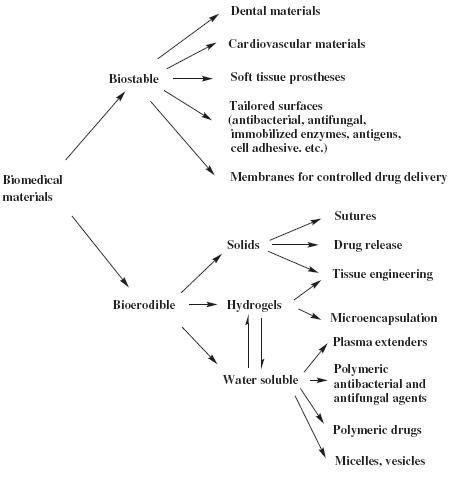Introduction
Biomedicalmaterialsarematerialsusedtodiagnose,treat,repairorreplacedamagedtissuesandorgansorenhancetheirfunctionsinorganisms.Itisthebasisforthestudyofartificialorgansandmedicaldevices,andhasbecomeanimportantbranchofcontemporarymaterialsscience.Especiallywiththevigorousdevelopmentandmajorbreakthroughsofbiotechnology,biomedicalmaterialshavebecomeahotspotforscientistsfromallovertheworldtoconductresearchanddevelopment.
Thehistoryofhumanuseofbiomedicalmaterialsisaslongashumanhistory.Sincethebirthofhumanbeings,peoplehavebeenfightingagainstvariousdiseases.Biomedicalmaterialsareoneoftheeffectivetoolsforhumanbeingstofightagainstdiseases.Tracingbacktothehistoryofbiomedicalmaterials,theancientEgyptiansusedcottonfibersandhorsehairassuturestosuturewoundsaround3500BC.Thesecottonfibersandhorsehaircanbecalledprimitivebiomedicalmaterials.MexicanIndians(Aztecs)usedwoodchipstorepairtheskullsontheirhands.Dentures,noses,andearswerefoundintombsinChinaandEgyptbefore2500BC.Humanshavelongusedgoldtorepairmissingteeth.Accordingtoliterature,in1588,peopleusedgoldplatestorepairjawbones.In1775,therewasarecordofmetalfixationoffracturesinthebody,andin1800therewerealargenumberofreportsabouttheapplicationofmetalplatestofixfractures.In1809,someoneusedgoldtomakedentalimplants.In1851,somepeopleusedartificialtoothtraysandjawbonesmadeofvulcanizednaturalrubber.Thenewpolymermaterialsdevelopedatthebeginningofthe20thcenturyledtothebeginningofsystematicresearchonartificialorgans,andtheclinicalapplicationofartificialorgansbeganin1940.Becauseoftheclinicalapplicationofartificialorgans,thousandsofpatients'liveshavebeensaved,andthepainandtorturecausedbydiseasestopatientsandtheirfamilieshavebeenalleviated.Ithasattractedwidespreadattentionfromthemedicalcommunityandacceleratedthepaceofresearchonartificialorgans.Atpresent,itcanbesaidthatfromTianlingcovertotoebones,fromhumaninternalorganstoskin,frombloodtofacialfeatures,inadditiontothebrainandmostendocrineorgans,soybeanshavesubstituteartificialorgans.Accordingtothedevelopmenthistoryofbiomaterialsandthecharacteristicsofthematerialsthemselves,theexistingmaterialscanbedividedintothreegenerations.Theyallhavetheirowndistinctcharacteristicsanddevelopmentperiods,whichrepresentdifferentlevelsofthedevelopmentofbiomedicalmaterials.ThemedicalmaterialsusedbeforetheFirstWorldWarintheearly20thcenturycanbeattributedtothefirstgenerationofbiomedicalmaterials.Representativematerialsincludeplaster,variousmetals,rubber,andcotton.Mostofthematerialsofthisgenerationwereeliminatedbymodernmedicine.Thedevelopmentofthesecondgenerationofbiomedicalmaterialsisbasedonthedevelopmentofmedicine,materialsscience(especiallypolymermaterialsscience),biochemistry,physicsandlarge-scalephysicaltestingtechnology.Researchworkersarealsomostlyundertakenbymaterialcigarsormainlybymaterialsscientistsanddoctorsincooperation.Representativematerialsincludehydroxyapatite,tricalciumphosphate,glycolicacid,polyhydroxyethylmethacrylate,collagen,peptides,fibrin,etc.Thistypeofmaterialisthesameasthefirstgenerationofbiomedicalmaterials.Theresearchideaisstilltostrivetoimprovethemechanicalandbiochemicalpropertiesofthematerialitself,sothatitcanreplaceandsimulatethefunctionofbiologicaltissueinaphysiologicalenvironmentforalongtime.Thethird-generationbiomedicalmaterialisakindofbiomedicalcompositematerialthatcanpromotetheself-repairandregenerationofthehumanbody.Itisbasedontheunderstandingofthestructureandperformanceofvariouscelltissues,growthfactors,somatostatin,andgrowthmatrixintheorganism.Let'sresumetheconceptofbiomedicalmaterials.Theyaregenerallycomposedofphysiologically"active"componentsandcontrolcarrier"inactive"components,andhaveidealrepairandregenerationeffects.Thebasicideaistoendowthematerialwithspecifictargetedrepair,treatmentandpromotioneffectsthroughthecombinationofmaterials,thefusionofmaterialsandlivingcells,andthehybridizationoflivingmaterialsandartificialmaterials,soastoachievethemainorevenallofthediseasedtissues.Replacedbyhealthyregenerativetissue.Bonemorphogeneticprotein(BMP)materialistherepresentativematerialinthethirdgenerationofbiomedicalmaterials.
Indifferenthistoricalperiods,biomedicalmaterialshavebeengivendifferentmeanings.Itsdefinitionhasevolvedwiththecontinuousdevelopmentoflifesciencesandmaterialsscience.However,theyallhavesomecommoncharacteristics.Thatistosay,biomedicalmaterialsareakindofartificialornaturalmaterials,whichcanbemadeintopartsanddevicesaloneortogetherwithdrugsforthetreatment,enhancementorsubstitutionoftissuesororgans,andwillnotcauseacuteorchronicproblemstothehostduringtheeffectivetrialperiod.harm.However,becausethephenomenonoflifeisextremelycomplex,itistheresultofadaptingtotheneedsofsurvivalintheprocessofmillionsofyearsofevolution.Lifehasacertainabilitytopreciselyregulategrowth,regenerationandrepair,whichiscurrentlyimpossibleforallartificialorgansandbiomedicalmaterials.Comparable.Therefore,thecurrentbiomedicalmaterialsarefarfrompeople'srealexpectationsandrequirements.
Classificationofbiomedicalmaterials
Biomedicalmaterialscanbedividedintobone,tooth,joint,tendonandotherskeletal-musclesystemrepairmaterials,skin,breast,esophagus,respiratorytract,Bladderandothersofttissuematerials,artificialheartvalves,bloodvessels,cardiovascularcathetersandothercardiovascularsystemmaterials,bloodpurificationmembranesandseparationmembranes,gasselectivepermeationmembranes,contactlensesandothermedicalmembranematerials,tissueadhesivesandsuturesMaterials,drugreleasecarriermaterials,clinicaldiagnosisandbiosensormaterials,dentalmaterials,etc.
Biomedicalmaterialsareclassifiedintoinertbiomedicalmaterials,activebiomedicalmaterials,anddegradableandabsorbablebiomedicalmaterialsaccordingtotheirbiochemicalreactionlevelsinthephysiologicalenvironment.
Accordingtothecompositionandpropertiesofthematerials,biomedicalmaterialscanbeclassifiedasfollows:
Biomedicalmetalmaterials
BiomedicalmetalmaterialsaremetalsusedasbiomedicalmaterialsOralloys,alsoknownassurgicalmetalmaterialsormedicalmetalmaterials,areaclassofinertmaterials.Thistypeofmaterialhashighmechanicalstrengthandfatigueresistance,andisthemostwidelyusedimplantmaterialinclinicalapplications.Theapplicationofthistypeofmaterialisverywide,coveringallaspectsofhardtissue,softtissue,artificialorgansandsurgicalaids.Inadditiontorequiringittohavegoodmechanicalpropertiesandrelatedphysicalproperties,excellentphysiologicalcorrosionresistanceandbiocompatibilityarealsorequiredconditions.Themainproblemintheapplicationofmedicalmetalmaterialsisthediffusionofmetalionstosurroundingtissuesandthedeteriorationoftheimplantmaterial'spropertiesduetothecorrosionofthephysiologicalenvironment.Theformermaycausetoxicsideeffects,andthelatteroftenleadtoimplantfailure.Medicalmetalmaterialsthathavebeenusedclinicallymainlyincludepuremetalssuchastitanium,tantalum,niobium,zirconium,stainlesssteel,cobalt-basedalloys,andtitanium-basedalloys.
Biomedicalinorganicnon-metallicmaterials,orbioceramics
Includinginorganicnon-metallicmaterialssuchasceramics,glass,andcarbon.Suchmaterialshavestablechemicalpropertiesandgoodbiocompatibility.Generallyspeaking,bioceramicsmainlyincludeinertbioceramics,activebioceramicsandfunctionalactivebioceramics.
Biomedicalpolymermaterials
Medicalpolymermaterialsaretheearliestdeveloped,mostwidelyused,andmostusedbiomedicalmaterials,andtheyarealsoarapidlydevelopingfield.Ithastwosources:naturalproductsandartificialsynthesis.Inadditiontomeetinggeneralphysicalandchemicalperformancerequirements,thematerialmustalsohavesufficientbiocompatibility.Medicalpolymermaterialscanbedividedintotwotypes:non-degradableandbiodegradableaccordingtotheirproperties.Fortheformer,itisrequiredtobestableforalongtimeinabiologicalenvironment,withoutdegradation,cross-linkingorphysicalwear,andhavegoodphysicalandmechanicalproperties.Itisnotrequiredtobeabsolutelystable,butitisrequiredthatitselfandasmallamountofdegradationproductsdonothaveobvioustoxicandsideeffectsonthebody,andthematerialdoesnotcausecatastrophicdamage.Thistypeofmaterialismainlyusedinhumanbodysoftandhardtissuerestorations,artificialorgans,artificialbloodvessels,contactlenses,membranematerials,adhesivesandluminalproducts.Suchmaterialsmainlyincludepolyethylene,polypropylene,polyacrylate,aromaticpolyester,polysiloxane,polyoxymethyleneandsoon.Thedegradablepolymersmainlyincludecollagen,linearaliphaticpolyester,chitin,cellulose,polyaminoacid,polyvinylalcohol,polyhexylpropylesterandsoon.Theycancausestructuraldamageandperformancedegradationundertheactionofbiologicalenvironment,andtheirdegradationproductscanbeabsorbedandutilizedbythebodyorexcretedthroughnormalmetabolism,andaremainlyusedfordrugreleaseanddeliverytocarriersandnon-permanentimplantdevices.Accordingtothepurposeorpurposeofuse,medicalpolymermaterialscanbedividedintorepairmaterialssuchascardiovascularsystem,softtissueandhardtissue.Medicalpolymermaterialsusedinthecardiovascularsystemshouldemphasizetheirgoodanticoagulantproperties,donotdamageredbloodcellsandplatelets,donotchangetheproteinsintheblood,anddonotinterferewithelectrolytes.
Biomedicalcompositematerials
Biomedicalcompositematerialsarealsocalledbiocompositematerials,whicharebiomedicalmaterialscomposedoftwoormoredifferentmaterials.Comparedwiththeperformanceofallmonomers,theperformanceofcompositematerialshasagreaterdegreeofimprovement.Thepurposeofpreparingsuchmaterialsistofurtherimproveorimprovetheperformanceofacertainbiologicalmaterial.Suchmaterialsaremainlyusedtorepairorreplacehumantissuesandorgansortoenhancetheirfunctionsandthemanufactureofartificialorgans.Inadditiontotheexpectedphysicalandchemicalproperties,itmustalsomeettherequirementsofbiocompatibility.Itisnotonlyrequiredthatthecomponentmaterialsthemselvesmustmeetthebiocompatibilityrequirements,butalsothatpropertiesthatdetractfromthebiologicalpropertiesofthematerialsarenotallowedtoappearaftercompounding.Accordingtothebasematerial,biologicalcompositematerialscanbedividedintothreetypes:polymer-based,metal-basedandinorganicnon-metal.Theycanbeusedassubstratesofbiocompositematerials,aswellasreinforcementsorfillers,andtheirmutualmatchingorcombinationformsalargenumberofbiomedicalcompositematerialswithdifferentproperties.Usingbiotechnology,somelivingtissues,cellsandgrowthfactorsthatinducetissueregenerationhavebeenintroducedintobiomedicalmaterials,whichgreatlyimprovestheirbiologicalpropertiesandenablesthemtohavedrugtreatmentfunctions.Theyhavebecomeaveryimportantpartofbiomedicalmaterials.Directionofdevelopment.Accordingtothetypeandleveloftissuereactioncausedbythematerialimplantedinthebody,itcanbedividedintoseveraltypessuchasbiologicallyinert,biologicallyactive,biodegradableandabsorbable.Mosttissuesinhumansandanimalscanberegardedascompositematerials.Thedevelopmentofbiomedicalcompositematerialshasopenedupabroadwaytoobtaintrulybionicbiomaterials.
Bio-derivedmaterials
Bio-derivedmaterialsarebiomedicalmaterialsformedbyspeciallyprocessednaturalbiologicaltissues.Alsoknownasbio-renewablematerials.Biologicaltissuescanbetakenfromthetissuesofthesamespeciesordifferentspeciesofanimals.Specialtreatmentsincludefixation,sterilizationandmildtreatmentstoeliminateantigenicitywhilemaintainingtheoriginalconfigurationofthetissue,aswellasdismantlingtheoriginalconfigurationandreconstructinganewphysicalformTheintensetreatment.Sincetheprocessedbiologicaltissueshavelosttheirvitality,biologicallyderivedmaterialsareinanimatematerials.However,becausebio-derivedmaterialseitherhaveaconfigurationandfunctionsimilartonaturaltissues,ortheircompositionissimilartonaturaltissues,theyplayanimportantroleinmaintainingthebody'sdynamicprocessofrepairandreplacement.Mainlyusedforartificialheartvalves,vascularrestorations,skinmasks,fibrinproducts,bonerestorations,scleralrestorations,nasalimplants,bloodpumps,plasmaenhancersandhemodialysismembranes,etc.
Applicationanddevelopmentprospects
Sofar,therearemorethan1,000kindsofbiologicalmaterialsthathavebeenstudiedindetail,anddozensofthemarewidelyusedinclinicalmedicine,involvingmaterialsscienceVariousfields.Themaindrivingforcefortherapiddevelopmentofbiomedicalmaterialscomesfromtheagingofthepopulation,theincreaseofyoungandmiddle-agedtrauma,theincreaseofpatientswithdifficultdiseasesandthedevelopmentofhightechnology.Theaccelerationofpopulationagingandhumanpursuitofhealthandlongevityhavestimulatedthedemandforbiomedicalmaterials.Atpresent,thefocusofbiomedicalmaterialsresearchistofindbiomedicalmaterialswithbettertissuecompatibility,degradability,corrosionresistance,long-lasting,andmulti-purposeunderthepremiseofensuringsafety.
Thedevelopmentofcontemporarybiomaterialsnotonlyemphasizestheimprovementofthephysicalandchemicalpropertiesofthematerialitselfandthebiosafetyandreliability,butalsoemphasizestheendowingofitsbiologicalstructureandbiologicalfunctions,sothatitcanbemobilizedinthebodyandexerttheself-repairofthebodyAndperfectabilitytoreconstructorrecoverdamagedhumantissuesororgans.CombiningtheviewsofProfessorYuYaotingofNankaiUniversityandthe2004ChinaNewMaterialsDevelopmentReport,thelatestprogressanddevelopmenttrendofthecurrentinternationalbiomedicalmaterialsdisciplinecanbesummarizedasfollows:
Tissueengineeringmaterialsarefacingmajorbreakthroughs
Tissueengineeringreferstotheapplicationoftheprinciplesandmethodsoflifescienceandengineeringtoconstructabiologicaldevicetomaintainandpromotethegrowthofhumancellsandtissuestorestorethefunctionofdamagedtissuesororgans.Itsmaintaskistorepairandrebuilddamagedtissuesororgans,extendlifespanandimprovehealth.Themethodisto"plant"specifictissuecellsonabiomedicalmaterial(tissueengineeringmaterial)thathasgoodbiocompatibilityandcanbegraduallydegradedandabsorbedbythehumanbodytoformacell-biomedicalmaterialcomposite;thebiomedicalmaterialisThegrowthandreproductionofcellsprovideathree-dimensionalspaceandanutrientmetabolismenvironment;withthedegradationofmaterialsandthereproductionofcells,newtissuesororganscorrespondingtotheirownfunctionsandmorphologiesareformed;thisvitaltissueororgancandamagethediseaseThestructure,formandfunctionoftheorganizationororgansarereconstructed,andapermanentreplacementisachieved.Inthepast10years,tissueengineeringhasdevelopedintoaninterdisciplinarysubjectintegratingbioengineering,cellbiology,molecularbiology,biomedicalmaterials,biotechnology,biochemistry,biomechanics,andclinicalmedicine.
Biomedicalmaterialsoccupiesaveryimportantpositionintissueengineering.Atthesametime,tissueengineeringalsoraisesquestionsandpointsoutthedevelopmentdirectionforbiomedicalmaterials.Sincetraditionalartificialorgans(suchasartificialkidneyandliver)donothavebiologicalfunctions(metabolism,synthesis),theycanonlybeusedasauxiliarytreatmentdevices,andtheresearchontissue-engineeredartificialorganswithbiologicalfunctionshasattractedwidespreadattentionallovertheworld.Theconstructionoftissueengineeringartificialorgansrequiresthreeelements,namely"seed"cells,scaffoldmaterials,andcellgrowthfactors.Recently,duetothestrongdifferentiationabilityofstemcells,ithasbecomeahotspottousethemas"seed"cellstoconstructartificialorgans.Tissueengineeringhasachievedsomebreakthroughresultsinartificialskin,artificialcartilage,artificialnerve,artificialliver,etc.,showingbrightapplicationprospects.
Currentresearchanddevelopmentofsofttissueengineeringmaterialsaremainlyfocusedonthestudyofnewbiodegradablebiomedicalmaterials,usingphysical,chemicalandbiologicalmethodsaswellasgeneticengineeringmethodstotransformandmodifytheoriginalmaterials,andtherelationshipbetweenmaterialsandcellsReactionandsignaltransductionmechanisms,thelawsandprinciplesthatpromotecellregeneration,thefunctionsandprinciplesofcellularmechanisms,etc.,aswellasthedevelopmentofmembranematerialswithselectivepermeabilityandsurfacemodification,andthedevelopmentofintelligentpolymermaterialsthatcaninducecellsandtissuesetc.
Currently,theresearchandapplicationdevelopmentofhardtissueengineeringmaterialsmainlyfocusonthecompositeresearchofcarbonfiber/polymermaterials,inorganicmaterials(bioceramics,bioactiveglass),andpolymermaterials.
Biomedicalnanomaterialsareemerging
Nanobiomaterialsaremainlyusedinmedicineascontrolledreleasematerialsanddrugcarriers.Nano-biomaterialscanbedividedintometalnanoparticles,inorganicnon-metallicnanoparticlesandbiodegradablepolymernanoparticlesintermsofmaterialproperties;nano-biomaterialscanbedividedintonano-liposomes,solidlipidnanoparticles,Nanocapsules(nanospheres)andpolymermicelles.
Nanotechnologyhasmadebreakthroughprogressinthe1990s,anditsapplicationresearchinthefieldofbiomedicinehasalsobeencontinuouslyexpanded.Currentresearchhotspotsaremainlydrugcontrolledreleasematerialsandgenetherapycarriermaterials.Controlleddrugreleasereferstotheprocessbywhichdrugsarereleasedthroughbiologicalmaterialsataconstantspeed,targetedpositioning,orsmartrelease.Biomaterialswiththeabovepropertiesarethekeytoachievingcontrolledreleaseofdrugs,whichcanimprovethetherapeuticeffectofdrugsandreducetheirdosageandtoxicsideeffects.DuetothecompletionoftheHumanGenomeProjectandcontinuousprogressingeneticdiagnosisandtreatment,scientistsareconfidentinusinggenetherapytotreattumors.Genetherapyistoguidehumannormalgenesinspecificcells(cancercells)torepairdefectiveordisease-causinggenes;orguidehumanstoexpressproteingeneswithcancertreatmentfunctions,orguidehumanstopreventdiseaseinthebodyGenessynthesizeproteingenefragmentstopreventdisease-causinggenesfromfunctioning,soastoachievethepurposeoftreatment.Thisisahugeadvancementintherapeutics.Thekeytogenetherapyisthecarrierthatguideshumangenes.Onlywiththeaidofthecarriercannormalgenesenterthenucleusofhumancells.Atpresent,polymernanomaterialsandliposomesareidealcarriersforgenetherapy.Theyhavethecharacteristicsoflargecarryingcapacityandhighsafety.Recently,anewlysynthesizeddendriticpolymermaterialisworthyofattentionasacarrierofgeneintroduction.
Inaddition,biomedicalnanomaterialsalsohavegoodapplicationprospectsinanalysisanddetectiontechnology,nanocompositemedicalmaterials,assemblywithbiologicalmacromolecules,anddeliveryofantigensorvaccines.Nano-carbonmaterialscansignificantlyimprovethestrengthandtoughnessofartificialorgansandtissues;nano-polymerparticlescanbeusedforinterventionaldiagnosisandtreatmentofsomedifficultdiseases;artificiallysynthesizednano-scalebone-likeapatitecrystalshavebeenBecomethebasisforthepreparationofnanobone-likebio-compositeactivematerials.Thefuturedevelopmenttrendinthisfieldisthedevelopmentofthecombinationofnano-biomedicalmaterials"components"withnano-medicalinorganicmaterialsandcrystalstructure"components",suchasnano-robotscontrolledbynano-microelectronics,anddrugorgantargeting;throughnanotechnologyToenableinterventionaldiagnosisandtreatmenttodevelopinthedirectionofmicro,micro,minimallyinvasiveornon-invasive,rapid,functionalandintelligent;nano-bioactivebiomimeticmedicalcompositematerialsthatsimulatethecomposition,structureandmechanicalpropertiesofhumantissues.
Activebiomedicalmaterialshaveyettobedeveloped
Activebiomedicalmaterialsareaclassofmaterialsthatcantriggerspecialbiologicalreactionsatthematerialinterface.Thisreactionleadstotheformationofchemicalbondsbetweenthetissueandthematerial.ThisconceptwasdiscoveredandputforwardbyAmericanL.Henchwhilestudyingbioglassin1969,andthenintroducedtheconceptofbioactivityinthefieldofbioceramics,creatinganewfieldofresearch.Aftermorethan30yearsofdevelopment,theconceptofbiologicalactivityhasestablishedasolidfoundationinthefieldofbiomedicalmaterials,suchas-tricalciumphosphateabsorbablebioceramics,etc.,whichcanbedegradedandabsorbedinthebodyandreplacedbynewtissues.Theroleofspecialbiologicalreactions;becausehydroxyapatiteisthemaininorganiccomponentofnaturalbone,itcannotonlyconductboneformation,butalsoformbonebondwithnewbone.Whenimplantedinmuscles,ligamentsorsubcutaneously,itcaninteractwithThetissuesaretight,withoutinflammationorirritation.Thesespecialbiologicalpropertiesofbioactivematerialsareconducivetotherepairofhumantissuesandareanimportantdirectionfortheresearchanddevelopmentofbiomedicalmaterials.
Thedevelopmentofbiomedicalmetalmaterialsisimperative
Thedevelopmentofmetalbiomaterialsisrelativelyslow,butbecausemetalmaterialshavehighmechanicalstrengthandexcellentfatiguepropertiesthatothermaterialscannotmatch,Itisstillthemostwidelyusedforce-bearingimplantinclinicalpractice.Thecurrentresearchhotspotsareinthetwodirectionsofnickel-titaniumalloysandnewbiomedicaltitaniumalloys.ThedevelopmentdirectionistouseZr,Nb,Ta,Pd,SnalloyingelementswithexcellentbiologicaladaptabilitytoreplacethetoxicAl,V,etc.inthetitaniumalloy.Inaddition,researchonbiomedicalmagnesiumalloysthatcancorrodeandabsorbbodyfluidshasjuststarted.
Newmethodsandnewtechnologiesforsurfacemodificationofmaterialsshouldalsoexploresurfacemodificationresearch
Thegoalistogreatlyimprovethecompatibilityofbiomedicalmaterialswithorganisms.Biocompatibilityincludesbloodcompatibilityandtissuecompatibility,whichisabasicrequirementfortheapplicationofbiomedicalmaterials.Inadditiontodesigningandmanufacturingnewmaterialswithexcellentperformance,thetraditionalmedicalmaterialsaresubjectedtosurfacechemicaltreatment(surfacegraftingofmacromoleculesorgroups),surfacephysicalmodification(plasma,ionimplantationorionbeam)andbiologicalmodification.Sexistheeffectiveway.Newmethodsandnewtechnologiesforsurfacemodificationofmaterialsareapermanenttopicintheresearchofbiomaterials.Somecurrentlypopularmethodsincludeplasmasurfacemodification,ionimplantationsurfacemodification,surfacecoatingandthinfilmsynthesis,self-assembledmonolayers,surfacemodificationofmaterials,andsoon.Thisfieldhasbecomeoneofthemostactive,eye-catchingandrapidlydevelopingfieldsofbiomaterials.
Theemergenceofresearchoninterventionaltherapymaterials
Interventionaltherapyreferstotheuseofpunctureneedles,guidewires,Preciseinstrumentssuchascathetersenterthediseasedareafortreatment.Interventionaltherapycanachievethesameorbettertherapeuticeffectassurgerywithminimaltrauma.Interventionaltreatmentmaterialsincludestentmaterials,cathetermaterialsandembolizationmaterials.Implantationofintravascularstentsisanimportantmethodforthetreatmentofcardiovasculardiseases.Atpresent,mostcoronarystentsaremadeofmedicalstainlesssteelbyengravingorlaseretching,andarefixedontheinnerwallofthebloodvesselbyself-expanding,balloon-expandingorexpansioninthebody.Althoughpercutaneouscoronaryinterventionhasachievedgoodresults,theincidenceofrestenosisafter6monthsafterpercutaneouscoronaryangioplastyishigh(about30%),whichisanimportantproblemfacinginterventionaltherapy.Inrecentyears,theresearchdirectionsincludedrug-coatedstents,radioactivestents,coatedstents,degradablestents,etc.Lumenstentsaremostlymadeofnickel-titaniumshapememoryalloy,andtherearetwotypes:self-expandableandballoon-expandable.Mainlyusedforbiliarystricturecausedbyadvancedmalignanttumors;treatmentofdyspneacausedbyadvancedtracheal,bronchialormediastinaltumors,benignbronchialstenosis,etc.;esophagealfistulaandmalignantrefractoryesophagealstenosiscausedbyunresectablemalignanttumors.Thematerialsusedtomakethecatheterarepolyethylene,polyurethane,polyvinylchloride,polytetrafluoroethyleneandsoon.Theouterlayerofthecatheterismostlypolyester,polyethylene,etc.,whichcanprovidehardnessandmemory,andtheinnerlayerissmoothPTFE.Embolicmaterialscanbedividedintothreetypes:inactivetothebody,autologousmaterialsandradioactiveparticlesaccordingtothenatureofthematerials.Theidealembolicmaterialshouldmeettherequirementsofnon-toxic,non-antigenic,goodcompatibility,canquicklyoccludebloodvessels,canoccludebloodvesselsofdifferentcalibersanddifferentflowsasneeded,easytotransportthroughcatheters,easytoobtain,easytosterilizeandotherrequirements.Ahigherrequirementistobeabletocontrolthelengthoftheocclusionofthebloodvessel,andonceneeded,itcanberecoveredpercutaneouslyorthebloodvesselcanberecanalized.Commonlyusedembolicmaterialsincludeautologousbloodclots,gelatinhippocampus,micro-collagenfibers,andcollagenvelvetpolymers.

Bloodpurificationmaterials
Theapplicationofbloodpurificationmaterialsisbasedontheprincipleoffiltrationsedimentationoradsorption,whichwillbespecifictoendogenousorexogenouspoisons(pathogenicsubstances)inthebody.Oritcanberemovedwithhighselectivitytoachievethepurposeofcuringdiseases.Itisaneffectivetreatmentforvariousdifficultdiseases.Uremia,variousdrugpoisonings,immunediseases(systemiclupuserythematosus,rheumatoidarthritis),hyperlipidemia,etc.canallbetreatedwithbloodpurificationtherapy,thecoreofwhichisbiomedicalmaterialssuchasfiltersandadsorbents.TheresearchandclinicalapplicationofbloodpurificationmaterialshavebecomeahotspotinthedevelopmentofbiomedicalmaterialsinJapanandEurope.
Compositebiomedicalmaterialsarestillthefocusofdevelopment
Asthemainbodyofhardtissuerepairmaterials,compositebiomedicalmaterialshavereceivedextensiveattention.Ithasthecharacteristicsofhighstrengthandgoodtoughness,andhasbeenwidelyusedinclinicalpractice.Throughthecombinationofmaterialswithdifferentproperties,theeffectof"learningfromeachother'sstrengths"canbeachieved.Itcaneffectivelysolvetheproblemsofmaterialstrength,toughnessandbiocompatibility.Itisaneffectivemeansforthedevelopmentofnewvarietiesofbiomedicalmaterials.Improvingthedegreeofbonding(compatibility)betweentheinterfacesofcompositematerialsisthemaintopicintheresearchofcompositebiomedicalmaterials.Accordingtothedifferentwaysofuse,therearemoreresearches:alloys,carbonfiber/polymermaterials,inorganicmaterials(bioceramics,bioactiveglass)/polymermaterialscompositeresearch.
Dentalmaterialsarestilldeveloping
Dentalmaterialsscienceistheinterfacebetweenstomatologyandmaterialsscience.Therearemanyvarietiesandclassificationmethods,whichcanbedividedintooralorganicpolymers.Materials,oralinorganicnon-metalmaterials,oralmetalmaterials,andoralauxiliarymaterialscanalsobedividedintoporcelainmaterials,plantingmaterials,fillingmaterials,bondingmaterials,impressionmaterials,andrefractoryembeddingmaterials.Inrecentyears,tissueengineeringtechnologyhasbeenappliedinoralclinics,mainlyintheapplicationofmembrane-guidedtissueregenerationtechnologyandperiodontalsurgicaltreatmentandimmediateimplantrestoration.Biomimeticmaterialsindentalmaterialsarestilltobestudiedanddiscussedinthefuture.Thefragileflexuralstrengthofceramicmaterialshasalwaysplagueddentistsandpatients.Theproblemofcolorreproductionindentalprostheticsisanimportantfactoraffectingtheobjectivenessofteethandrestorations.Therefore,dentalceramictechnologyisdevelopedinthedirectionofovercomingthebrittlenessofmaterials,accuratelymeasuringthecolorofteethandprovidingceramicmaterialswithstablecompositionandperformance.
Biocompatibilityevaluationstandardsareconstantlyimprovinganddeveloping
Theresearchofnewbiocompatibilitycontentputsforwardnewrequirementsforthebiologicalevaluationofmaterials,inadditiontothecurrentISO10993standardInaddition,thenewevaluationmethodwillbedevelopedfromthefollowingaspects:①theinfluenceofbiomedicalmaterialsonthehumanimmunesystem;②theinfluenceofbiomedicalmaterialsonvariouscytokines;③theinfluenceofbiomedicalmaterialsoncellgrowthandapoptosis;④Theinfluenceofdegradablecontrolledreleasematerialsonhumanmetabolism;⑤Theinfluenceofsmartmaterialsonhumaninformationtransmissionandfunctionregulation;⑥Biocompatibilityevaluationofcontrolledreleasematerialsofdrugs,purificationfunctionalmaterials,andtissueengineeringmaterials.
Thebiologicalresponseofbiomedicalmaterialstothehumanbody
Theidealbiomedicalmaterialshouldbenon-toxic,non-allergenic,non-irritating,non-genotoxicandnon-carcinogenictohumansAdversereactionssuchassex.Therefore,itisveryimportanttounderstandthebiologicalresponseofbiomedicalmaterialstothehumanbody.Thesereactionsmainlyincludetissuereaction,bloodreactionandimmunereaction.
Tissueresponseofbiomedicalmaterials
Tissueresponsereferstothereactionoflocaltissuestobiomedicalmaterials.Tissueresponseisthebody'sdefensiveresponsetoforeignbodyinvasion,whichcanreducethedamageofforeignbodiestotissuesandpromotetissuerepairandregeneration.However,thetissueresponseitselfmayalsocauseharmtothebody.Accordingtothedifferentpathologicalchanges,itcanbedividedintothefollowingtwokindsofreactions:
1.Thetissuereactiondominatedbyexudation
Itismorecommonintheinitialstageofimplantationandthestablenatureoftheimplantmaterial..Mainlyexudedbyneutrophils,serum,andfibrinogen.Forexample,neutrophilsgatherinthetissuesurroundingtheimplant;aroundthelong-termimplanted,stablematerial,fibrinogenmaybeexudedandfibrouscapsulesmayappear.
2.Tissueresponsedominatedbyhyperplasia
Itismorecommoninthelong-termexistenceofimplantsanddamagetothebody.Mainlymacrophages,lymphocytes,plasmacellsandeosinophilscanalsobeseen,accompaniedbyobvioustissueproliferation,whichcangraduallydevelopintogranulomasortumors.
Intheprocessofusingbiomedicalmaterials,twoseriouscomplicationscausedbytissuereactionsareinflammationandtumors.Inflammationincludesinfectiousinflammationandasepticinflammation.Infectiousinflammationmaybecausedbydamagetotissuesduringtheprocessofmaterialimplantation,allowingpathogenstotakeadvantageofit;itmayalsobebecausetheimplantitselfhasnotbeenstrictlydisinfectedandsterilizedandhasbecomeacarrierofpathogens.Asepticinflammationisnotcausedbytheinvasionofpathogens,butiscausedbytheinflammationandtheregulationoftheanti-inflammatorysysteminthebody.Theimplantationofbiologicalmaterialstocausetumorsisaslowprocess,whichmaybeduetothereleaseoftoxicsubstancesfromthematerialitself,orduetotheshapeandsurfacepropertiesofthematerial.Therefore,beforeapplyinglong-termimplants,itisnecessarytoconductbiologicaltestsonthechronictoxicity,mutagenicityandcarcinogenesisoftheimplants.
Thebloodreactionofbiomedicalmaterials
Thebloodcompatibilityofbiomedicalmaterialsincludestwoaspects:nobloodcoagulationandnodamagetobloodcomponents.Withinacertainlimit,evenundertheshearingactionofthesurfacetensionofthematerial,itwilldamagetheredbloodcellsinthebloodtoacertainextent(thatis,hemolysisoccurs).Becausebloodhasastrongregenerativeability,itsadverseeffectsarenotsignificantovertime.;Andifthereisthrombosisonthesurfaceofthematerial,duetothecumulativeeffect,thedegreeofcoagulationwillbecomehigherandhigherovertime,whichwillcauseseriousimpactonthehumanbody.Therefore,thematerialthathasreceivedthemostattentioninbloodisitsanticoagulantproperties.ThewayinwhichmaterialscontactwithbloodleadstocoagulationandthrombosisasshowninFigure1.Thebloodinthecardiovascularsystemofthenormalhumanbodyremainsinaliquidstate,circulatesendlessly,anddoesnotcoagulate.Whenmedicalmaterialscomeintocontactwithblood,itwillcauseaseriesofchangesinblood.Thefirstistheadsorptionofplasmaproteinonthesurfaceofthematerial.Dependingonthesurfacestructureandperformanceofthematerial,within1minuteorevenafewseconds,thecompetitiveadsorptionofalbumin,globulinandvariousproteinswilloccuronthesurfaceofthematerial,formingacomplexsurfaceonthesurfaceofbiologicalmaterials.Theproteinadsorptionlayer.Whenglobulinandfibrinogenareadsorbedonthesurfaceofthematerial,itiseasyforplateletstoadheretothesurface,whichinturncausesplateletstodeformandaggregateandinitiatecoagulation.Theproteinsurfacecanalsocausetheadhesionofredbloodcells.Althoughtheroleofredbloodcellsinbloodcoagulationisstillnotveryclear,ifthecellmembraneoftheredbloodcellsisruptured,hemolysiswilloccur.ThehemoglobinandadenosinediphosphatereleasedbytheredbloodcellsarereferredtoasADP(platelet-promotingsubstances).Theycancausetheadhesion,deformationandaggregationofplatelets,whichinturncanleadtobloodclotting.
`
Figure1Coagulationmechanism
Theanticoagulationsystemincludesanticoagulationandfibrinolysis.Theanticoagulanteffectismainlyachievedthroughsomeanticoagulantfactors(suchasantithrombinIII,heparin).Theprocessoffibrinolysisincludestheconversionofplasminogentoplasmin,whichdegradesfibrin.Thrombosisisacommonlocalbloodcirculationdisordercausedbytheimplantationofbiomedicalmaterials.Endothelialcelldamage,hemodynamicchanges,andblood'shypercoagulablestate,anyofthesefactorscanleadtothrombosis.IntactendothelialcellscaninactivateIIa,Xa,IXabyexpressingheparin-likemoleculesandcombiningwithantithrombinIII,SynthesizePGI2,NOandADPenzymestoinhibitplateletaggregationandsynthesizetPAtodegradefibrinandinhibitthrombusformation.Changesinhemodynamicscaninducethrombosis.Normalbloodflowisstratified.Whenthebloodflowslowsdownorthelaminarflowisdisrupted,plateletscontacttheinnermembraneandactivate,andclottingfactorscanalsoaccumulatelocally.Whenintrauma,surgery,etc.,theblood'scoagulationsystemishyperactiveand/ortheanticoagulationsystemisweakened,whichcanalsoleadtothrombosis.
Immuneresponseofbiomedicalmaterials
Theimmunesystemisthe"army"and"policeman"ofthehumanbody.Itcanidentifyitselfandnon-self.Themainfunctionsoftheimmunesystemincludeimmunedefenseagainstpathogenicmicroalternativemolecules,immunehomeostasisagainstauto-aginganddiseasedcells,andimmunesurveillanceagainsttumorcells.Theimmunesystemconsistsofthenaturalimmunesystemandtheacquiredimmunesystem.Thenaturalimmunesystemincludesmastcells,macrophages,naturalkillercells,neutrophilsandcomplement.Theinnateimmunesystemcanrecognizeandeliminatepathogensearly,butitisnotspecificforpathogenrecognition.Afterbeingstimulatedbypathogens,theimmunesystemthatcanrespondspecificallywhenexposedtopathogensagainbecomestheacquiredimmunesystem.TheacquiredimmunesystemcanbedividedintohumoralimmunitymediatedbyBcellsandcellularimmunitymediatedbyTcells.Asthefunctionoftheimmunesystem(includingimmunerecognitionandreactiondegree)disordercausedbybiomedicalmaterials,thefollowingimmunereactionscanoccur:
1,immunosuppression
BecausesomebiomedicalmaterialscauseimmunityInsufficientdefensefunctionmakesthebody'sabilitytoresistpathogenicmicroorganismslower
low.
2.Allergy
Becausesomebiomedicalmaterialscausetheimmunedefensefunctiontobehyperactive,theimmuneresponseistoostrongtodamagethehumanbody.Suchasresiduallatex,bisphenolA,acrylicacidadditivesandotherlowmolecularweightorganicmoleculesormonomers.
3.Autoimmunity
Becausesomebiomedicalmaterialscauseimmunehomeostasishyperfunction,theimmunesystemcannotidentifyitselfandnon-self,andproducesanimmuneresponsetothenormaltissuesofthebody.Suchaspolytetrafluoroethylene,polyesterandsoon.
Theinterfacebetweenbiomedicalmaterialsandhumantissues
Theinterfaceisanareawithacertainthickness(usuallylessthan0.1μm).Theenergyofthematerialcanpassthroughthisareafromacontinuousphase.Changetoanotherphase.Accordingtothedifferentimplantmaterials,theinterfacewiththebiologicaltissuecanbedividedinto:theinterfacebetweentheinertmaterialandthebiologicaltissueandtheinterfacebetweentheactivematerialandthebiologicaltissue.
1.Theinterfacebetweeninertbiomedicalmaterialsandbiologicaltissues.Thecharacteristicofinertbiomedicalmaterialsisthattheyremainstableintheorganismandhardlyparticipateinthechemicalreactionoftheorganism.Long-termimplantationofinertmaterialswillcauseanexudativetissuereactionbetweentheimplantandthebody,amongwhichfibrinogenexudatesmainlytoformfibrouscysts.Ifthematerialdoesnotoozeoutoftoxicsubstances,thecystwillgraduallybecomethinner,lymphocyteswilldisappearandcalciumsaltswillbedeposited.Suchmaterialsincludealumina,carbonfiber,titaniumalloyandsoon.Ifthematerialcontinuestoreleasetoxicionssuchasmetalionsororganicmonomers,itwillcausethelocaltissueresponsetolingerandturnintochronicinflammation.Thefibrousmembranegraduallythickens,lymphocytesincrease,andcalciumsaltdeposits,whichcandevelopintogranulomasandeventumors.
2.Theactivebiomedicalmaterialinteractswithbiologicaltissues.Theactivebiomedicalmaterialcanreactchemicallywiththebodyandformachemicalbondwiththetissue.Herewemainlyintroducetheinterfacebetweensurface-activebiomedicalmaterialsandbiologicaltissues,theinterfacebetweendegradablebioceramicsandbiologicaltissues,andtheinterfacebetweenhybridbiomedicalmaterialsandbiologicaltissues.
(1)Interfacebetweensurfaceactivebiomedicalmaterialsandbiologicaltissues:Surfaceactivebiomedicalmaterialshavesimilarsurfacecomponentstotissuecomponentsandcancombinewithtissuestoformastablebindinginterface.Thismaterialhasagoodaffinitywiththeorganization.Suchasbiologicalmaterialscontaininghydroxyapatiteonthesurface.
(2)Theinterfacebetweenbiodegradablebioceramicsandbiologicaltissues:ceramicscanreleasethecomponentsrequiredbythetissuesinthetissues,acceleratethegrowthofthetissues,andgraduallybereplacedbynewtissues.Forexample,β-tricalciumphosphateceramicscanreleaseCa2+,PO4
3+ionsinbodyfluids,promotethegrowthofbonetissue,andgraduallyreplacethem.
(3)Theinterfacebetweenhybridbiomedicalmaterialsandbiologicaltissues:hybridmaterialsarewovenandcompoundedbylivingtissuesandnon-livingtissues
.Becausetheexistenceoflivingtissuesreducestheimmuneresponseofthematerial,thematerialhasgoodcompatibility.
Thistypeofmaterialincludesavarietyofartificialmaterialsandbiopolymercomposites,syntheticmaterialsandcellcomposites,etc.
3.Interfacetheoryanditsresearchmethods
(1)Interfacewettingtheory;mainlystudytheaffinityofliquidtosolidsurface.Materialimplantationisfirstlyincontactwiththeliquidenvironmentcomposedofplasmaandtissuefluid,sotheaffinityofthematerialandthebodytissueiscloselyrelatedtothewettingeffectoftheliquidandthesurfaceofthematerial.Generally,theinterfacialenergyisdeterminedbystudyingthecriticaltensionofthesolidsurfacewettingandthewettingangleoftheliquidonthesolid.
(2)Interfaceadsorptiontheory;bystudyingtheadsorptionofwatermolecules,variouscells,aminoacids,proteinsandvariousionsontheinterface,itprovidesareferenceformaterialinterfacemodification.Theprinciplesandmethodsofbiorheologycanbeusedtounderstandtheinfluenceofthemorphologicalsurfaceofthematerialontheadsorptionofcells.
(3)Interfacechemicalbondingtheory;theoreticallyspeaking,theimplantandhumantissueareinthesameinternalenvironmentofthehumanbody,andthereisthepossibilityofformingvariouschemicalbonds.Mainlyuseelectronprobe,electronenergyspectroscopy,massspectrometry,nuclearmagneticresonance,Ramanspectroscopy,etc.toanalyzeinterfaceelementsandtheirchemicalstates.
(4)Interfacemolecularbindingtheory.Implantmaterialshavedifferenteffectsonhumantissuesduetotheirdifferentsurfacepolarity,surfacechargeandactivegroups.Bymeasuringthemicro-currentgeneratedbythebio-piezoelectricmaterial,evaluateitsinfluenceontheformationofthecellinterface.
(5)Interfaceacid-basetheory;sincethegrowthofinterfacecellsisdirectlyrelatedtothelocalpHoftheinterface,itispossibletounderstandandimprovetheaffinitybetweenbiomedicalmaterialsandtissuesbystudyingtheinterfacepH.Ininvitroexperiments,conventionalpHmeasurementmethodsandnanometerultramicroelectrodesareusuallyusedtodeterminetheinterfacepH.
(6)Thetheoryofinterfacephysicalcombination;thecombinationofimplantandhumantissueisfirstphysicalcombination,andtissuecellsgrowintotheimplantthroughthemicroporestoincreaseitsbondingstrength.Thesizeoftheporesisrelatedtowhetherthetissuecellscangrowintotheimplant,andtheratiooftheporesdeterminesthestrengthoftheimplant.Mainlyusevarioussensingtechnologies,photoelasticstressanalysismethod,finiteelementcalculationanalysismethod,etc.todeterminethebondingstrengthandstressoftheinterface.
Inaddition,interfaceresearchmethodsalsoincludeinterfacemorphologicalresearch.Themorphologyattheinterfaceismainlyobservedthroughtransmissionelectronmicroscope,scanningelectronmicroscopeandvariousstereoimagingtechniques.
Biomedicalmaterialsarethemetabolitesandpathwaysinthehumanbody
Generallyspeaking,biomedicalmaterialsfirstcomeintocontactwithbodyfluidsinthebody.Throughhydrolysis,somematerialsmaybecomposedofpolymers.Thesubstanceistransformedintoawater-solublesmallmoleculesubstance.Thesesmallmolecularsubstancesaretransportedtotherespiratorysystem,digestion,andurinarysystemthroughbloodcirculation,andareexcretedfromthebodythroughbreathing,feces,andurine.Intheprocessofmetabolism,theremaybeenzymesinvolved.Afteraseriesofreactions,biomedicalmaterialsmaybecompletelydegradedanddischargedfromthebody,orsomematerialsortheirdegradationproductsmayexistinthehumanbodyforalongtime.Theintermediateandfinalproductsofbiomedicalmaterialsmetabolisminthebodymaybebeneficialorharmfultothehumanbody.Therefore,itisofgreatsignificanceforthestudyofthemetabolitesandpathwaysofmaterialsinthebody.Themetabolismofmaterialsinthebodyisaffectedbymanyfactors,suchasthefactorsofthematerialitselfandthefactorsoftheimplantationenvironment.Atpresent,theresearchmethodsofmaterialmetabolisminvivoaremainlydividedintoinvitrotestsandinvivotests.Theinvitrodegradationtestismainlytosimulatetheenvironmentalconditionsinvivoinvitro,andevaluatefromtheaspectsofappearance,mechanicalproperties,andquality.Thiskindoftestismainlyusedtostudysolidbiomedicalmaterials.Invivoexperimentsaremainlycarriedoutinanimals.Invivotestingistoimplantbiomedicalmaterialsintoanimalstoobservethechangesinthematerials.Specifically,itcanbedonebydissection,X-ray,radioactivelabelingandothermethods.Theadvantageofthistestmethodisthatthetestresultsclosertothehumanbodycanbeobtained.
Furtherreading
[1]RatnerBD.Biomaterialsscience:anintroductiontomaterialsinmedicine:Academicpress;2004.
[2]SikavitsasVI,TemenoffJS,MikosAG.Biomaterialsandbonemechanotransduction.Biomaterials.2001;22:2581-93.
[3]WilliamsDF.Onthenatureofbiomaterials.Biomaterials.2009;30:5897-909.
[4]LloydAW,FaragherRG,DenyerSP.Ocularbiomaterialsandimplants.Biomaterials.2001;22:769-85.
[5]NairLS,LaurencinCT.Biodegradablepolymersasbiomaterials.Progressinpolymerscience.2007;32:762-98.
[6]ParkJ,LakesRS.Biomaterials:anintroduction:Springer;2007.
[7]ZhengYufeng,LiLi.BiomedicalMaterialsScience.NorthwesternPolytechnicalUniversityPress.December2009,1stEdition
[8]XiTingfei.CurrentStatusandDevelopmentTrendsofBiomedicalMaterials.ChineseMedicalDevicesInformation.2006;12:1-4.
[9]LiYubao,WeiJie.Nano-biomedicalmaterialsandtheirapplications.JournalofChineseAcademyofMedicalSciences.2002;24:203-6.
[10]ZhangZhen,LuXiaofeng.Thecurrentstatusandtrendoftheeffectivenessandsafetyevaluationofbiomaterials.JournalofBiomedicalEngineering.2002;19:117-21.
[11]YuSiRong.Researchstatusanddevelopmenttrendofbiomedicaltitaniumalloys.MaterialsScienceandEngineering.2000;18:131-4.
